
|
|
Abstract: The Great Peace March was a cross-country event from Los Angeles to Washington DC in 1986 to draw attention to nuclear proliferation. This article interviews three Bahá'ís who participated. Prefaced by essay "The Wilderness Trek of the Great Peace March." Notes: See also Wikipedia article Great Peace March for Global Nuclear Disarmament. See also list of dialogue articles or image scans. |
Bahá'ís and the Great Peace March
by Steven Scholl and Robert Ballenger
published in dialogue, 1:2, pages 12-20Los Angeles: 1986
"The Wilderness Trek of the Great Peace March," by Robert Ballenger, in dialogue 1:2, pp. 12-13 (1986)
In terms of personal commitment, intensity and dedication, the ambitious venture resembled one of the Great Crusades of the 11th and 12th centuries.In terms of organization, financing and execution, it looked a lot more like the ill-fated Children’s Crusade of 1212.
David B. Mixner, a Los Angeles political consultant and peace activist, had a dream. He wanted to lead a nationwide “Great Peace March” on a 255-day, 3,235-mile trek across America’s midsection.
The goal of this grassroots crusade was to mobilize American public opinion and create such a powerful climate for global nuclear disarmament that the world’s political leaders would have to dismantle their atomic arsenals.
But the lofty ideals fueling Mixner’s American peace odyssey tripped over the grubby realities of life.
The march left Los Angeles on March 1, lasted two weeks and got as far as Barstow, California, 120 miles east. There, it collapsed in a chaos of bad weather, broken promises, bitter feelings and lawsuits from creditors.
Roughly 300 marchers have continued slogging on, hoping to make the original goal of reaching Washington, D.C. sometime in November. But the high-gloss motif and the self-conscious, media-posturing passion that characterized the Great Peace March died in the empty, windswept reaches of the Mojave Desert.
Even before the first pace was stepped off, there were ominous signs it would be a short trip to nowhere.
From its beginnings, the grandiose enterprise was plagued by logistical foul-ups, threatened with cancellation by the lack of liability insurance, stymied by the reluctance of local governments to issue camping permits for the marchers and hassled by staff turnover, burnout and dissention.
Mixner’s enterprise, dubbed PRO-Peace (People Reaching Out for Peace), was snubbed as a hare-brained scheme by almost all established peace and civil rights groups.
Turnout for the march was a major disappointment. Instead of the 5,000 stalwart volunteers expected to swell the ranks for the trans-America trek, only about 1,400 were mustered in when the outing started. Roughly half of them almost immediately dropped out, claiming they had been lied to about essential arrangements such as food, showers and shelter.
March organizers, who budgeted $21 million for the eight-month crusade, were only able to raise about $4 million in cash and pledges by its beginning. The financial picture never got brighter. As the march got underway, advance personnel were reduced to begging local churches along the route for money and places to bed down the walkers.
But the most ironic symbol of those collective woes was Mixner himself. About a week before the march stepped off, Mixner sprained his ankle. He limped noticeably the day the march began, hobbling about with the aid of a cane as he led his troops on their kickoff mile.
As the days wore on, the money ran out. Mixner spent much of his time on the phone, frantically trying to drum up enough cash to keep the march on its feet. Nothing worked, nothing helped. In the end, Mixner’s dream evaporated. He threw in the towel, accepting full responsibility for the $300,000 debt that had been run up.
Meanwhile, the re-organized peace march, shrunken but hardened, continues to wend its way across the country. The marchers have survived nasty weather, balky equipment, gnawing hunger, near bankruptcy and endless internal wrangling over how to do what they want to do. They show the grit and determination to make it all the way to Washington.
“We’re changing the march from an event to a movement,” says Joe Kinczel, a peace march official. “We want to get people into peace marching, which is our signature, and into peace camping, which is also our signature.
“We’re building a mailing listing and now have 40,000 people on it. We want to hit Washington, D.C. with 1,000 to 1,500 marchers and have another 20,000 to 30,000 supporters mail letters and cards to elected officials to ask them what they are doing to further the goals of the Great Peace March.
“I don’t think we are naive enough to think that, when we come to Washington, the congressmen and senators will say, ‘We give up,’ but we do intend to keep up the pressure.”
The re-organized peace march has succeeded in shedding its media-event patina and is a more honest, grassroots undertaking. But a fundamental goal still stubbornly eludes the marchers as they tramp across the miles. Instead of igniting anti-nuclear passions in the towns they pass through, the Great Peace Marchers hardly stir a ripple in their wake.
Robert Ballenger is Dialogue’s Assistant Editor.
"Bahá'ís and the Great Peace March," by Steven Scholl, in dialogue 1:2, pp. 14-20 (1986)
When the Great Peace March left Los Angeles on the 1st of March, three Bahá'í women were among the 1,500 peace activists. Pamela Maddock of Walnut Creek, California; Myrlaina Seraphin of Chicago, Illinois; and Briar Willard of Santa Cruz, California left behind the security of their homes and careers and joined a high-risk adventure that turned into an organizational nightmare (see accompanying story). The choices made by these three Bahá'ís are representative of decisions made by the marchers en masse. Pam, tired of the lies and confusion, left the march. After the new Great Peace March, Inc. had reorganized and landed on its feet, Myrlaina joined a small band who left the march and walked to Big Mountain, Arizona to support the attempt to halt the relocation of Navajo Indians. She is now travelling by bus on a caravan that is criss-crossing the country, educating and entertaining for peace. Briar remains on the Great Peace March, working on the advance team that goes into towns prior to the marchers arrival, setting up media coverage, hospitality, logistics, and public speaking engagements.On March 25th I drove out to the California desert town of Barstow and spoke with Pam and Myrlaina—Briar was in Las Vegas preparing for the first leg of the resurrected march. I caught up with Briar by telephone on July 14. The following are excerpts from our conversations.
As we go to press, the Great Peace March is making its ways through the American heartland of Iowa. Dramatically scaled back from its original goals, the Peace March still hopes to gather thousands of names for a peace issues mailing list and draw attention to the need for a dramatic shift in American defense policies. The PRO-Peace organization failed to obtain support from national peace groups. The U.S. Bahá'í National Spiritual Assembly was among many groups that contacted PRO-Peace prior to the March 1st kick-off date only to be rebuffed in its attempt to initiate any cooperative endeavour with PRO-Peace. The new march has been more successful working with national and local peace groups. For more information on The Great Peace March and how you can lend a hand, contact:
The Great Peace March
1431 Ocean Ave.
Santa Monica, CA 90401
(213) 458-7387
MADDOCK: I came on the march originally because I thought there would be a lot of teaching opportunities, which there are. And I wanted to be around people who were people conscious 24 hours a day. And I wanted to be with Myrlaina. Plus the adventure of walking across the country was appealing. I don’t know if I was ever terribly convinced that this would make a great political impact. I wasn’t real sure about that. I mean, if it did, that would be great, but I wasn’t sure. We did a lot of little things in the communities and stuff that I’m real happy about. That wasn’t my goal…. I’m not convinced that the political power was going to be toppled. It was more of a personal thing. I wanted to be here.
DIALOGUE: What kinds of reactions did you get from your fellow Bahá'ís when you told them you were going on the peace march?
MADDOCK: Actually, the Bahá'ís in my area were extremely supportive, extremely supportive with money. Even my parents were very supportive, once they realized I was really going. They’re used to me being crazy. I was surprised that I had a lot of support from the Bahá'ís in my area. I didn’t get official support from the assembly. They had contacted National, and National wouldn’t let them do that. But, as individuals they gave me support.
DIALOGUE: So, you arrived in Los Angeles a week before the March set off. What kind of preparation took place then.
MADDOCK: Everybody was signing up for classes. We had a million classes planned, it seemed like. The Christians wanted to get together, the Jews wanted to get together, the homosexual support groups—there was a support group for everything. All these classes that were planned. Tai Chi [Chinese exercises] went on every morning. It was incredible. We had nothing else to do except develop ourselves. It was great. That’s what we did the first week. We weren’t doing anything but camping and getting ready for the march with planned classes. We had firesides each night, we had teaching. Not firesides so much, but more like prayer sessions. (One night) we shared a Bahá'í prayer book; our friends said a few Bahá'í prayers and we said the Lord’s Prayer and it was different stuff. We shared a lot. It was a really Bahá'í atmosphere, everybody knew they were in a Bahá'í tent. In fact, we started out with just Bahá'í stuff. And I said, “You know, you guys, we don’t have to say Bahá'í things, you can say what you want.” And they felt a lot more comfortable. We had a lot of that. There was a lot of teaching going on.
DIALOGUE: What happened to you when the march began disintegrating?
MADDOCK: I couldn’t believe it. I just thought, in Griffith Park, when they told us that—well, first of all, for a long time they would just try to get rid of us. Ever day, we would have a town meeting. They’d say. “Redecided, this is not the march you signed up for. Redecide.” And I thought, “we just got here. I gave up nine months. I just sold everything. I just got out of school. I’m not going to go home.” They would find every way they could to get rid of us. I think that they knew the march was going to fail and they kind of wanted us to back out. I think that was part of it and part of it was that they just wanted to weed out [some marchers], which made me sick. They were trying to make it real elite: “Okay, whoever hasn’t donated so much money, leave. Okay, all the kids, leave; if you’re not here with your parents, leave. Okay, such-and-such, leave.” You know, it was like this was supposed to be a people’s march and, all of a sudden, the feeling was everybody hated it. So, when it started crumbling, I just didn’t believe it. A lot of us just didn’t believe it.
DIALOGUE: You made it out here to Barstow and had to make a decision, to stay or leave.
MADDOCK: The thing that made me sick, emotionally sick…was all the backbiting and all the rumors flying around. Like, for example, you just heard, “I’m going to Big Mountain tomorrow.” And then you walk over the hill and they say, “Oh, it’s been cancelled.” That went on constantly. It was like rumors going crazy. We made jokes about Rumor Control. We had a Rumor Control task force. That was just a rumor. The rumors were flying: oh, PRO-Peace this, oh, David Mixner that, duh-duh-duh-duh-duh-duh-duh. It was ridiculous. “We’re moving out tomorrow.” And then you’d wake up in the morning and nobody would pack up their tent. It was ridiculous. And that’s what got me down. I just got so sick of it. I just decided to leave then. Also we expected showers, we expected mail. All we got was sleeping bag liners. At first, that was hard to deal with, but everybody adjusted….I mean, the conditions I could handle because you adjust, get tougher. That was fine, but it was the constant lying, all the lies you catch them in.
They [the PRO-Peace organizers] lied to us in that they knew we were going to fold, but they didn’t want to tell us on the way because too much media was there. They wanted us to fold in the desert. I think that was part of the big lie. I’m not too upset about that now. That day I was upset about it.
The thing that made me decide to go was a lot of my friends left and I just thought, I might as well leave. It was very intense. I just decided about three days before they went bankrupt that, when PRO-Peace folded, I would, too. I had already decided to leave. I was just kind of waiting it out. So, the day they said, “We’re going under,” I went and called up my boyfriend and said, “Come and get me.”
DIALOGUE: As the new march makes its way across the country, how can Bahá'ís get involved and assist the marchers?
MADDOCK: Send money and have the Bahá'ís come out and greet the marchers. When we go to cities, they always contact the churches before we get there. And they weren’t even calling the Bahá'ís. And I met the lady that was calling the churches and I said, “Look, if you want to call the Bahá'ís, you could tell them, hey, there’s three Bahá'ís here.” And they did. And that night, they had—this was in Barstow—the Bahá'ís in Barstow had a hundred places for marchers to sleep. The marchers ended up turning it down because we didn’t need it. But all the marchers knew about that. You’ve got a captive audience (of marchers). Anybody that helps them is No. 1 on their list. But, when the marchers come to the Bahá'í homes, we’ve got to be really accepting of their lifestyles because they’re not always—well, you just have to be real accepting.
DIALOGUE: Let’s broaden this from just PRO-Peace to peace. As a Bahá'í, what was it that led you to make this kind of commitment? Why is peace the issue for you?
MADDOCK: I don’t think I would have come on this trip if I wasn’t a Bahá'í. I thought it would be real important that at least one or two of us were represented on the march. It makes me sad when I go to fundraisers to keep the Indians on their land and ERA meetings and I’m the only Bahá'í that shows up. Because, if we’re supposedly going to save this world, we at least have to be out there, showing that we care. That’s why I came.
DIALOGUE: Some Bahá'ís would see your action as political and, possibly inappropriate. This is, after all, a demonstration with political objectives. How do you respond to that?
MADDOCK: I don’t. I ignore them. I’ve run into—I dunno, we’re always advisors, trying to govern each others lives. That’s ridiculous. I don’t know how to answer that [accusation of political involvement] because I don’t deal with that. If they don’t like it, and they don’t like it enough to harass me about it, I don’t need to be around them because I feel real good about what I’m doing. On the same point, I think the same thing about them: why aren’t you out here? What can you do?
I think things like what’s going on in South Africa and stuff, I think it’s ridiculous and we need to do something politically about it now. I think the overall peace is not partisan. The purpose of this march was to take the weapons down. So, we take the weapons down, we still don’t have peace the way Bahá'ís see peace. So, I think there has to be a balance, politically right now, since the world is political and ruled by our governments; that’s how we need to make changes. But, I hope some day in the future that we can do it through our hearts.
DIALOGUE: How should Bahá'ís be involved in the peace movement?
MADDOCK: I think Bahá'ís should get more involved in peace groups and get known. They don’t have to find partisan peace groups. Creative initiative, for example, is not terribly partisan; they don’t go demonstrating and stuff. Bahá'ís should get more out into the community because we’re so isolated. I understand that because we have a lot of work to do ourselves. But, it’s terrible when you go to these peace events and people say, “Well, why are you here?” “I’m a Bahá'í.” “You’re a what?” They should know by now what the Bahá'í Faith is, especially those in the peace movement. I mean, the people here are the people that are going to be interested in the Faith. Why aren’t we hanging out with peace activists? I want the Bahá'í community to be respected by other groups and it should be because I think we have a lot to offer. The writings have a lot to offer. So often, I tell people about the Faith and they say, “What are the Bahá'ís doing about this or that?” and I just say, “Well, not a lot.” We talk about changing the world, but we’re not doing it….I felt a responsibility to come here with the [Bahá'í] Peace Message, because that’s what it’s all about.
SERAPHIN: I was born in Haiti and I lived there for about seven years and lived various other places, Florida and Illinois, California and back to Chicago. My father’s still in Haiti. He’s not permitted to leave the country just yet. They’re still in transition, and he still works for the government, and so that’s where his loyalties lie. Let’s see, I’ve been a Bahá'í…for about seven years. My background’s in business administration. I was planning to move to Seattle. And I was working out a business plan this year. I’ve got a couple of people doing some research for me right now. I think what I’d like to do is probably manufacturing. So, that’s really it in a nutshell. I’m just taking this year off to think and re-write my business plan and work for peace and teach the Faith.
DIALOGUE: I’ve been wandering around the camp this afternoon talking with some of the marchers. There’s a very strong spirit among these 300 who refused to call it quits after PRO-Peace folded. Clearly, they are all committed to this particular action with all its attendant risks and sacrifices. What is your motivation for being here?
SERAPHIN: I came on the march, naturally, because of the Promise of World Peace statement. That was my feeling. I realize that ‘Abdu’l-Bahá would have given anything to have an opportunity to teach like this and walk across the United States for an issue, for peace. I’m doing it for the world and for my unborn children and the children of the world. So, that was the main thing. I kind of looked at it as a year of service.
DIALOGUE: That’s interesting. It seems to me that most of us Bahá'ís have looked at the House of Justice’s peace statement as a proclamation event. You know, give it out to every public official in the land and have it written up in the newspaper. I’m impressed that you took the statement as a call to action. What kind of feedback have you received from Bahá'í friends and institutions?
SERAPHIN: It was interesting the kind of reactions I got from people before leaving. A great deal of the Bahá'í community was supportive. But there was that one or two that didn’t understand what the purpose of the Great Peace March was. For example, the editor of The American Bahá'í was fully prepared to give us a monthly column on the Great Peace March and what was happening. And, then there were a couple of people who decided “no”; and I think the main reason is because PRO-Peace in their bylaws hadn’t fully renounced civil disobedience as a means for achieving peace. But now that PRO-Peace has gone bankrupt, we’re creating this new structure in camp and writing our own bylaws. So, I think this could give us a different avenue to work with. And now, I think the Faith could openly support the Great Peace March as a spiritual body….They did give us a couple of plugs in The American Bahá'í.
DIALOGUE: How is the march changing?
SERAPHIN: It’s real exciting. I’ve been involved in the administration and reorganizing. But it is also difficult. There are some people who are so committed to the idea that the Great Peace March should only be the Great Peace March for nuclear disarmament and nothing else. But we’re more than that. We’re walking for peace, and taking down the bombs is just really one symptom. We have to address all social issues. At our last campsite, where PRO-Peace fell apart, two people from the Big Mountain/Navajo-Hopi joint-use area came and extended an invitation to the march as a whole to attend. Naturally, a lot of people were not really supportive of that. I’ve just decided to leave the march with about ten others. We’ve accepted Chief Long Walker’s invitation to help support the peaceful resolution of the Navajo-Hopi relocation issue.
Because the group has been so divided, we still have a lot of egos to deal with and people got caught up in different trips. For example, we haven’t spent a penny for food in the last three weeks. People have donated food to us. Everything that we’ve needed; they’ve taken us into their homes. Some marchers don’t seem to understand the giving and receiving process at all. And so, the sort of things that are going on in camp, the sort of wars; well, we have to wear our badges and identify ourselves so we know that everybody who’s eating our food are marchers. And they’re talking about closing the march to people that haven’t formally applied or limiting the number of marchers. That really defeats the purpose because it’s got to be an open march. People have got to be able to join, so why worry about food? That’s such a minor thing. We didn’t die in the desert. People came to our aid. And we stand to fall out of grace by the mere act of closing ourselves off.
DIALOGUE: How can Bahá'ís support the peace movement?
SERAPHIN: I don’t think we’re active enough. There are individuals who are out there, doing a hell of a lot of things. I’m proud of those people. I’m glad that the House of Justice issued the Promise of World Peace statement to really give us a tool to work with. I think it’s invaluable for people that just don’t know, or feel uncomfortable plugging into the present system as its stands. I don’t know, I guess it always comes back to the individual. It’s like this peace march. We can’t look to the organization to tell us what we need to do. It’s got to be a people’s march. I think we’re right on target with individual initiative. I think that’s the bottom line. I think our role is to mainly educate people and let them know what is available to them, I mean in terms of Bahá'í specifically. What are the issues they can get into and try to overcome this fear of activism. Like what you’re doing with Dialogue; I think we need more of that, just to let people know what areas they can plug into and dispel this myth of the Bahá'í Faith being the way, the truth and the light and nothing else. That’s really a tough one for me when people resist. This is all one. We’ve got to start looking with that world-embracing vision. And, I think, unfortunately, as Bahá'ís, we lock ourselves into this path, this religion.
DIALOGUE: What you’re saying about individual initiative by Bahá'ís as peace activists is crucial. But we also seem to be hearing the House of Justice emphasizing that Bahá'í communities and institutions must now take a new look at their collective actions and responsibilities.
SERAPHIN: I think that’s dynamic, and I hope so, but they’ve been telling us that for quite a number of years now. There’s still so much education that needs to be done in our Bahá'í communities. And, again, it comes down to individual initiative. It’s going to take one or two people coming up with new ideas, projects, and plans and making their proposal to the local assembly, and implementing that. We need to start locally, educating ourselves on nuclear issues and joining with other peace groups.
DIALOGUE: I hope there’s enough freedom in the community for there to be an explosion of diverse peace activist projects at the local level. Not all Bahá'ís need to be concerned with the same issues or even agree on tactics and strategies.
SERAPHIN: I see that happening. It’s happening in Chicago and I know it’s happening other places, too. And this new activism will help educate Bahá'ís who resist this change.
DIALOGUE: The peace movement has often been criticized for being too white middle-class, Martin Luther King, Jr. and Jesse Jackson notwithstanding. You’re a black woman and you are on a peace march that is, for the most part, composed of whites. What are your thoughts on the question of race and peace?
SERAPHIN: You know something, Steve, it’s not just a black issue or a white issue anymore. I mean, when I came here, there were people who were part of what used to be Ethnic Outreach, but we changed the name to Rainbow Coalition. Primarily because we’ve got to see beyond the color barriers. We’re all one now, so to speak. And people are always so quick to remind you what color you are. And that’s not the issue. We’re fighting for our lives right now. There are a couple of black people that were initially coming from this old, militant stance and I had to make it very clear that I’m not here to fight any old wars at all. I mean, I’m just here to be who I am, that I happen to be a black person, doing what I’m doing, is a minor point. I don’t know how to speak to black issues. I couldn’t begin to tell you. I can speak to Haitian issues, perhaps. We’ve evolved too much as a people to zero in on such a small focus. I’m not sweeping it under the carpet. Perhaps, to a lot of people racial prejudice is the most challenging issue, but it’s not to me. Besides, I don’t think we can disconnect these issues. Issues of economics, racism, hunger, and the war economy are all related.
DIALOGUE: Already you’ve been through heat, storms, freezing rain. How are you holding up?
SERAPHIN: One day is like a week; it’s so intense and there’s so many things that go on throughout the course of a day. It’s a march of uncertainty. You just don’t know what’s going to happen next. It’s exciting in one regard, but it’s also very, very trying, too. I’ve never felt so alive before. It’s wonderful. It’s being outdoors, learning to commune with the elements. I have no desire to do anything other than what I’m doing right now. I mean, there’s no other way I can work for peace full time, 24 hours a day; really connecting with people and helping show that they do have a voice.
WILLARD: I have a background in organic farming and I was managing a health food store in Santa Cruz when I heard about the march. It just struck me as the right thing to do. I made up my mind quickly, and then packed up my stuff, put it in storage and joined the march. Of the three Bahá'ís who started the march, I’m the only one still with it. One marcher has become a Bahá'í, but there isn’t much information out here and nothing has been done administratively.
DIALOGUE: What is your role on the march?
WILLARD: Until recently I was the Religious Outreach Coordinator. I would go into a town ahead of the march as part of our advance team to make contact with all religious groups in a city. My job was to see how we could work together, peace marchers and religious groups. Of course I also called the Bahá'ís and they would often adopt me. The Bahá'ís along the route have been great. They’ve taken me in, provided hot showers and hospitality, and set up speaking engagements for me at firesides and deepenings. It’s been wonderful.
DIALOGUE: What is your message at these meetings?
WILLARD: I talk about peace and Bahá'í principles and how the march coincides with these principles. Also, I note how the marchers are picking up some of the Bahá'í ways of doing things. It’s really exceptional. For example, we have elections for our city council and I suggested the Bahá'í form of elections where there are no campaigns and no nominations. We are now discussing adopting this method of election for Peace City. Sometimes marchers will come and ask me, “Briar, what is the Bahá'í way to do this?”
DIALOGUE: When I was in Barstow, I was struck by the religious dimension of the march. It seemed like a good number of those who stuck it out and resurrected The Great Peace March out of the ruins of PRO-Peace are motivated by their religious faith. You’ve mentioned the Religious Outreach committee. How does this spiritual dimension of the march manifest itself on the road?
WILLARD: Well, in every town we try to hold an interfaith worship service. I’ve rotated out as Religious Outreach coordinator as this time. Judith Ain, an Episcopalian deacon, is now coordinator. One thing I emphasized, and is being continued, is that we can’t just contact the Christian churches. We need to get a hold of all religious organizations and be truly ecumenical. Judith is great. A couple of times in the worship services she has said, “I’d like to remember the Bahá'ís suffering persecution in Iran for their beliefs.”
DIALOGUE: As the march makes its way to Washington, D.C., are there ways Bahá'ís can help out if their town is on the route?
WILLARD: Sure, in Denver 12 Bahá'ís marched with us for a day and at the Colorado border we were greeted by two Bahá'ís with welcome signs and banners. These kinds of support really mean a lot to us on the march. Bahá'ís might also adopt a marcher. I mean, you have 600 seekers coming to town. Some of the marchers are very interested in the Faith, and these kinds of support reverberate to the good of the Faith. Also, there are some 50 children marching with their families. I think it would be great if Bahá'ís set up special children’s classes where our young marchers could tell Bahá'í children about the march and their feelings about peace. These kids are incredible!
DIALOGUE: As a Bahá'í, how do you relate to the political aspects of the march?
WILLARD: Being a Bahá'í is a political statement. I avoid divisive, partisan activism, but I think we need to stand up and be counted. The march is a legal march and it neither supports or disapproves of civil disobedience. Some marchers have done CD, but it is always made clear that they do this as individuals and that civil disobedience is not a part of The Great Peace March’s platform. We Bahá'ís need to be leading this generation on matters of peace and social justice.
DIALOGUE: Everyone knows about the trials and tribulations the march has gone through. Many people, frankly, look at this as a quixotic affair. How is it going? Do you feel you are making progress in getting your message across and making an impact?
WILLARD: We’ve now marched just over half the distance and we are earning more and more respect. We are beginning to get more media coverage and it is more positive than before. Mother Jones, US News & World Report, and other national magazines are doing stories on the march. Pete Seeger and Ram Das recently came out to march with us and they said they’ll be coming back. The march has developed so much since Barstow. Peace City is well organized with our elected mayor and city council. And our finances are together now. The talent in this group is phenomenal. We have movies, a couple of music groups and a theatre group. The theatre group just put on their version of Shakespeare’s The Twelfth Night, making play with our diversity, helping us laugh at our own differences on the march. We are no longer a disoriented and stumbling band of dreamers. Now, we are coming out of the sparsely populated Midwest and into the more populated northeast. We expect to have over 1,000 marchers through the east coast and are planning a rally of over a 1 million in Washington, D.C. on November 15th. There will be a special prayer vigil on the night of the 14th and on the 15th we will encircle the capitol and march into the capitol, 1 million strong, from all directions. The planning for the rally and the rest of the march are coming along. All Bahá'ís are invited to Washington. It’s going to be tremendous!
Letters to the editor, in dialogue 1:4, pp. 4-5 (1987)
PEACE PERSPECTIVEI was incensed after reading Robert Ballenger’s article on the Great Peace March, “The Wilderness Trek,” in your special peace issue (Spring 1986).
“Hardly stir a ripple,” indeed. How did he know? Did he stay with the march all the way? Did he see people greeting us with love, tears of emotion, signs, and banners welcoming us? In so many towns, sumptuous potluck dinners were served; it seemed that they felt they could not do enough for us. Generosity, kindness and love are what we received. Never did we beg for anything. How could Ballenger make such a statement? I was there, and saw it all, through nine of the most incredible and remarkable months of my life. We never suffered the “gnawing hunger” he alleged. We were extremely well-nourished with healthful, nutritious and plentiful meals. Occasionally in bad weather some churches gave a few of us shelter from pouring rain.
The “hardly a ripple” Ballenger described turned into a mighty wave as I personally experienced it. We made a tremendous impact throughout the country, meeting hundreds of thousands of people and touching the lives of several million more. We received media attention from the press, radio, and personal contacts. We had jubilant rallies and speakers, and people joined us as we marched. I started the march feeling cynical and skeptical, but all that was gradually replaced by a tremendous respect for the people of this country, who despise war and the killing of humans for power, greed and wealth. To them the bomb is an anathema. They called us saints, missionaries of peace, and peace advocates. We spread love and got love in return. I cannot imagine a greater mission, one with more fervently dedicated spiritual people. I’ll never forget the tears we shed when schools were let out and all the children were waving and smiling and holding banners proclaiming our mission of peace. This happened all along the way, and I can assure you, those children will never forget us. We rippled right into their hearts with our message of Global Nuclear Disarmament and the outlawing of war and legal murder. They stood in awe of us, and just wanted to touch us and see if we were for real. Their sweet, dear and innocent faces, big round eyes, and wondering expressions touched us profoundly. They made the arduous and difficult journey worthwhile many times over.
I was the oldest woman marcher at 76 years of age, and I can truly say I walked across this great land. I saw devastated towns and cities, desperate farmers, and the people’s terrible anger and hatred toward a government that spends billions to promote and escalate wars. Their rage was boundless. To think that they are suffering untold misery while trillions are spent on every manner of killing device imaginable. I spent a week in jail in Beatty, Nevada, because I dared step on the United States’ “sacred” property, especially reserved for testing bombs to destroy millions of humans in one shot.
Will I ever forget the desperate, frightened mother who clutched me to her bosom and begged me to help save her children? I carried that mother’s message all across this country: “Don’t Let Our Children Die, Mr. Reagan.” For this woman and many others like her, our long and difficult trek to Washington, D.C. was worth it. It may be a “ripple” that never, never stops.
- Suzanne Mendelson
Santa Monica, California
I found much food for thought in your Spring issue of dialogue.
Since you have particularly invited comments from outside the US, I felt that at least I must respond to Pamela Maddock, one of the peace marchers who wondered where the Bahá'ís were in terms of involvement with the peace movement and was at a loss as to how to respond when asked, “What are the Bahá'ís doing about this or that?”
I appreciate the spirit with which she joined that march and hope that, though her involvement was short-lived, she will use what she learned as a springboard for future services. I would have been tempted to join that march myself, but I have been involved in another kind of peace march for the past nine years: pioneering.
For Maddock and others who are not just sure what the Bahá'ís are doing as a “peace movement” I offer the following perspective: Which other peace groups do you know of who have a corps of thousands of volunteers spread all over the world working to raise consciousness and create the social and political climate for peace? In the past seven years alone, 3,694 of these volunteers have gone out from the US and they join in the field with co-workers from so many other countries. They are working to build communities on patterns of consultation and united efforts that can have a lasting effect in the world. (One cannot overestimate the peace-building value of raising maturely functioning LSAs.)
Which of the peace groups you are in touch with has members representing over 2000 distinct tribes, races and ethnic groups? How did we get these members? Not by protesting in the streets of America, I assure you, but by rushing out to embrace the world. How many of these peace groups has literature teaching a logical pattern for peaceful, democratic world order in over 757 languages? How many of these peace groups have leaders who walk through leach-infested jungles, cross mountains and deserts, and brave every environmental condition on the planet to take their message of peace to the hearts of people of every nation, race, class and creed?
These are but a few examples of what Bahá'ís are doing. But I can sympathize with the sense of discouragement that comes through in her statements (and in statements by others in this issue of dialogue). One thing we must realize is that there is an unimaginably great amount of work to be done, most of it at very fundamental levels, not in front of TV cameras or in the light of newspaper coverage. And because the Bahá'ís are a community spread thinly throughout the world it is sometimes hard to see that we are not, in fact, marching alone though we may not see many other active, dedicated Bahá'ís around us.
All I can report on is the part of the march I see from my pioneer post in the southwestern part of Japan. What are Bahá'ís doing about nuclear disarmament? My husband, for one, raises this issue and encourages every class of his university students to investigate the facts. This affects nearly 600 young people per year in a society that is strangely indifferent to peace issues in general.
What are Bahá'ís doing about problems of prejudice? I have yet to meet any other group so much involved in eliminating the age-old prejudices between Koreans and Japanese. The Bahá'ís of Japan who have visited Korea have fallen in love with these long-lost brothers and sisters. They carry back such tales of love, hospitality and friendship that non-Bahá'ís beg to be taken with them on their next visit. It is hard to describe the extent of change in the attitudes we see here.
Within their own society, Japanese Bahá'ís are involved in several ways in eliminating class prejudice which still exists despite official (political) abolishment over 100 years ago. Look at sexual equality: Japan has exemplary laws concerning the rights of women (much better even than the US), but the status of women in the workplace particularly (and in many cases in the home) would make any feminist choke. Yet equality of men and women is an outstanding characteristic of the Japanese Bahá'í community.
I encourage any US Bahá'í who is frustrated with the lack of visibility of the Bahá'ís in the peace movement to take a much broader look at their Faith and its influence around the world. American youth would do well to take seriously the call of the Universal House of Justice to go out of the U.S. and serve the Faith in another country for some period of time. In this way you will “see with your own eyes” and “know of your own knowledge” the work that needs to be done to bring healing and peace to the planet.
We are not merely involved in publicity stunts or drawing attention to ourselves by shouting out our grievances. We are engaged in moving the hearts of people to examine and make fundamental changes in how they view the value of human existence and then build the world anew through every daily decision and action. Each victory represents tons of effort, persistent effort. It is not that Bahá'ís are perfect or have learned to put all we know into practice. But we have heart, we have the power of the Covenant, we have divine teachings for this age, and, God knows, we are trying.
- Marilyn Higgins
Ube City, Japan
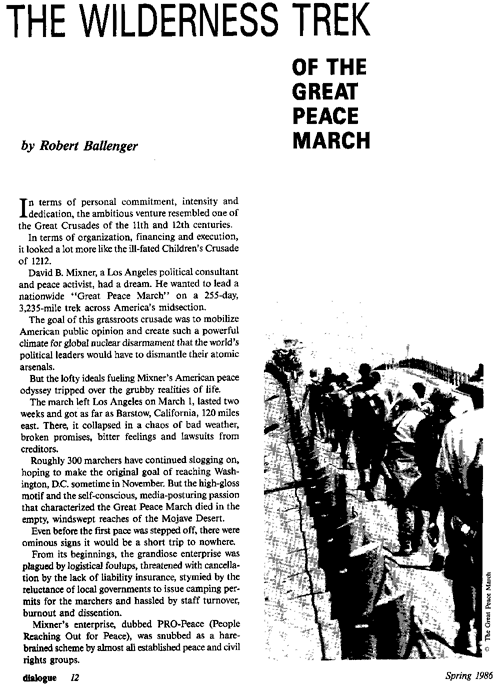 click for larger image |
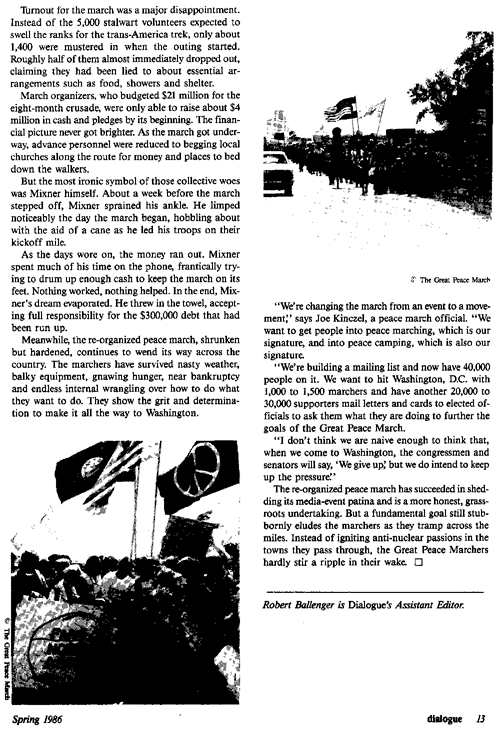 click for larger image |
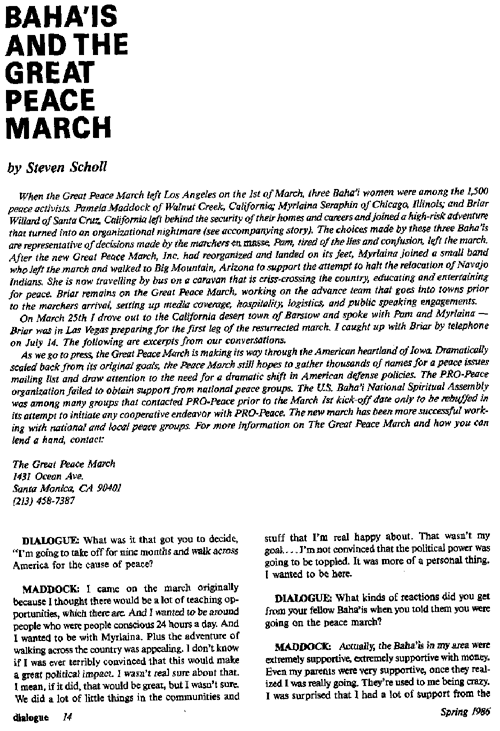 click for larger image |
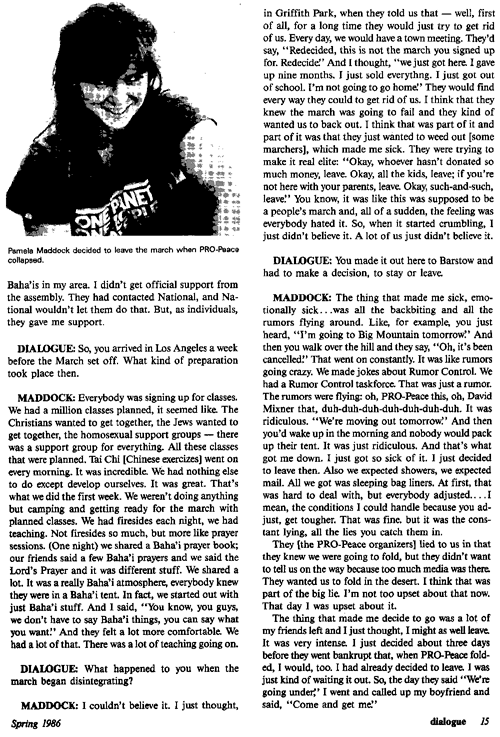 click for larger image |
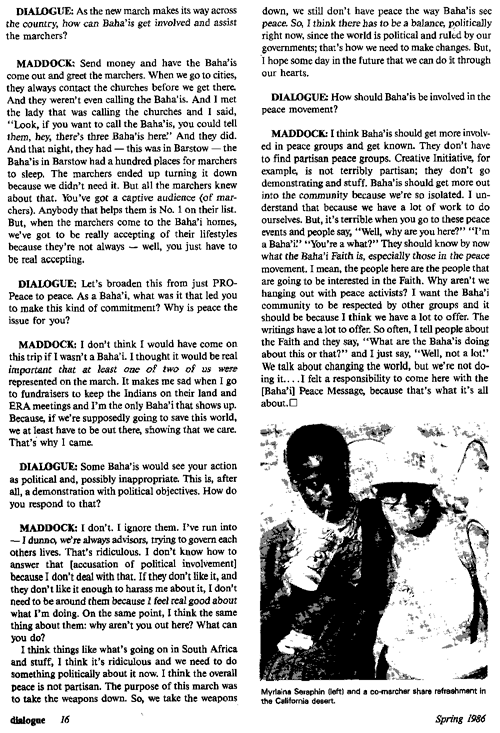 click for larger image |
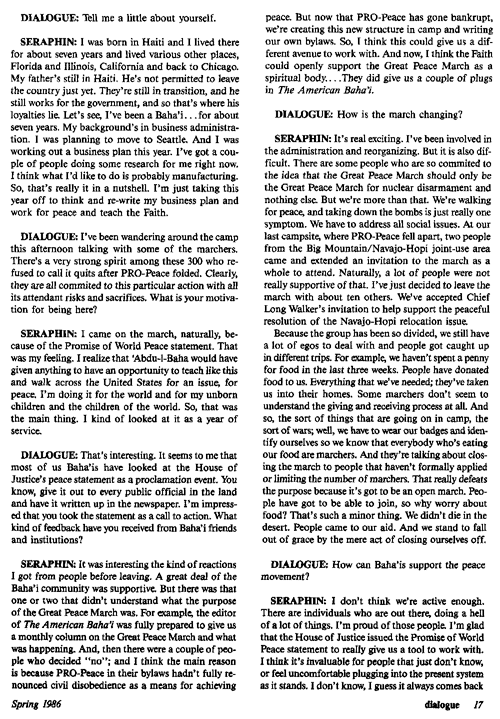 click for larger image |
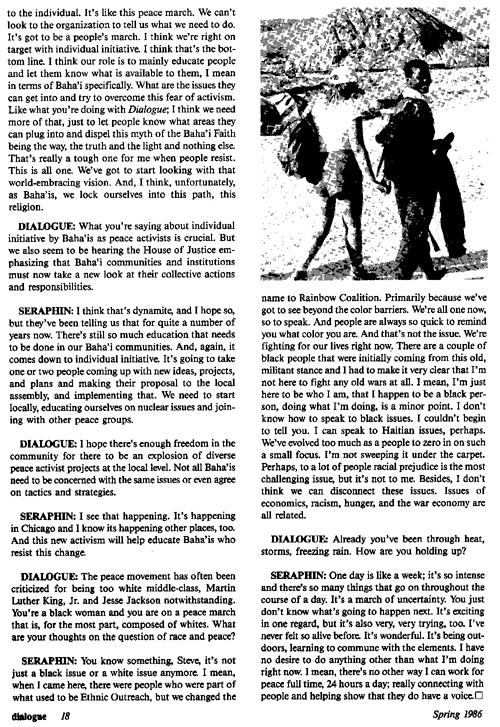 click for larger image |
 click for larger image |
 click for larger image |
Letters to the editor, in dialogue 1:4, pp. 4-5 (1987) |
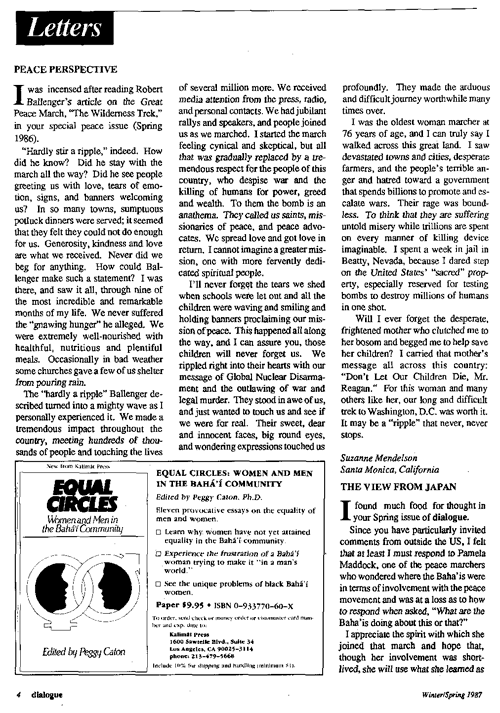 click for larger image |
 click for larger image |
|
|